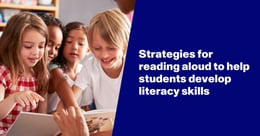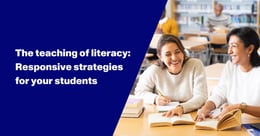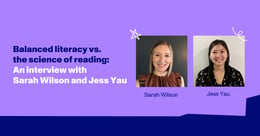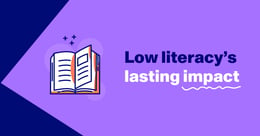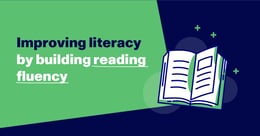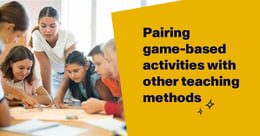
In-class activities for building literacy in the early grades
Building literacy in the early grades can set students up for a lifetime of opportunity. So what do early childhood educators and elementary and middle school teachers have to do to ensure their students are adequately prepared for what lies ahead?
From the moment a child utters their first word, they begin to take part in the transformative process of acquiring language. And with the benefit of comprehensive literacy instruction, children can develop the skills—and the enthusiasm—needed to become lifelong readers.
[READ: “How to teach reading: The K-12 guide”]
We’ll explore how educators can implement in-class activities to help their students become expert readers with the skills it takes to thrive.
Support for young children and guidelines for early childhood literacy
The process of child development involves the acquisition of a number of different skills and a variety of ways of navigating the world. As young ones discover how to interact harmoniously with their peers, they also take their first steps toward emergent literacy by recognizing the roles of print, written language, and words.
Building blocks for early literacy: Background knowledge, oral language, and print
A California State University guide to literacy development in early childhood education underscores the importance of regularly reading aloud to children and promoting language development through rich, expressive conversations. These interactions should take place in a safe environment where interesting, age-appropriate books and writing supplies are readily available and frequently used. For early literacy development, it’s especially helpful to forge strong connections between home and preschool or other outside centers.
To teach reading, place goals—and growth—at the forefront
During early childhood, and as students progress through their learning, focused literacy programs become an integral part of instruction. A primer on professional development opportunities for early literacy instruction emphasizes that teachers need to foster a learning space where assessments and data drive comprehensive educational strategies that are differentiated for individual students. Learners are encouraged to set goals and to reach for their targets. And for their part, educators provide progress monitoring, practice time, and structured activities to help students reach their objectives.
Driving literacy in the early grades with phonological awareness and comprehension activities
Dedicated instruction is instrumental for helping students develop their reading skills in the early grades. But that doesn’t mean there’s no room for fun too! After all, reading is a profoundly joyful experience for many, and learning to read can be just as fun and rewarding.
Fun activities that build phonemic and phonological awareness
As children gain an understanding of the sounds and syllables that make up words, there are lots of activities that can help make the process more enjoyable. In an article about phonological and phonemic awareness activities for kindergartners, WETA’s Reading Rockets recommends some original ideas of its own—as well as concepts from the Florida Center for Reading Research—such as:
- Playing games that focus on thinking up rhyming words.
- Participating in sound-based scavenger hunts.
- Incorporating phoneme practice into a picture-based game of dominoes.
Additional phonological awareness activities for first graders from the North Carolina Department of Public Instruction include:
- Exercises where students practice blending, counting, omitting, or adding sounds together to explore how words are made.
- Printable and online activities where students use pictures or tiles to build phonemic understanding.
Activities that promote fluency and elevate reading comprehension in the early grades
As students move from sounding out words to reciting full phrases, sentences, and paragraphs, it’s vital that they develop their fluency skills—the ability to read smoothly and expressively. Fun and engaging activities in which students can practice reading out loud are crucial.
[READ: “Raising reading fluency to improve K-12 literacy”]
And even in the early stages of their literacy journeys, students can have fun developing their comprehension skills. In a post that covers comprehension activities for first graders, Reading Rockets suggests:
- Having the student talk about a story while counting down on five fingers as they recap the characters, setting, events, and ending, as well as their favorite part.
- Drawing out the key settings or plot points covered in a book through a visual exercise such as a map or a timeline.
- Creating dramatic exchanges by filming book trailers together or role-playing as characters from the text in an interview setting.
Opportunities to promote independent reading and deep connections in third and fourth grade
A Scholastic parents’ guide to helping third graders read discusses how to support young students as they make the leap to chapter books, independent reading, and deeper reflection. The article suggests activities that focus on:
- Making broad connections by discussing how characters evolve throughout a book series or thinking about who the student’s favorite authors are and why.
- Building vocabulary by looking up unfamiliar words encountered during the process of reading.
Likewise, students in the next grade up are often encouraged to deepen their analytical abilities. Scholastic’s literacy guide for the parents of fourth graders suggests:
- Exploring how data visualization and other graphics in popular periodicals can augment and expand on the information contained in articles’ written text.
- Participating in a shared reading exercise and expressing opinions together about the book or its topic, perhaps even comparing multiple texts that explore the same subject.
As teachers continue to work from a structured curriculum tailored to individual students’ goals, they can incorporate these activities to help make learning come alive.
Moving from early childhood literacy and elementary reading to the middle grades
Like their peers in the younger grades, middle school students are often interested in learning new material through rich lessons that may consist of games or other immersive experiences. As these learners work on honing deeper and more sophisticated skills, teachers can use reading games and other compelling instructional formats to make learning fun, interactive, and meaningful.
Interactive lessons for bolstering comprehension, encouraging fluent readers, and more
Middle school students of all ability levels can work hard to develop foundational literacy skills—from fluency to vocabulary and comprehension. At this stage in a young learner’s development, the methods for teaching literacy and the topics that hold students’ interest are growing and expanding too.
Interactive lessons—including the entries available from the Inspiring Middle School Literacy resource center from PBS—can be used to motivate students by bringing together multimedia experiences, reading, writing, and fascinating new subject matter. Explore current events with your students or tap into their interest in STEM or social studies. With the right guidance, they could fall in love with words too.
Literacy games for middle school
Elementary school students aren’t the only ones who get to enjoy the fun and playfulness that can accompany game-based learning. However, keep in mind that the instructional procedures accompanying middle school literacy games may need to be leveled up a little bit to match the growing sophistication of students in these higher grade levels.
[READ: “7 tips to blend game-based activities with other teaching strategies”]
Educators in the middle grades can take inspiration from high school biology teacher and instructional coach Hannah Bradley, who described five vocabulary games she uses in her classroom. For example, in one game, the teacher creates a deck of cards that each feature vocabulary words. Then, in a timed exercise, one student pulls a card from the deck and tries to describe the word—without using it!—to their classmates.
Build literacy and language skills with games and activities
Clear, systematic instruction is instrumental to literacy learning. Still, that doesn’t mean reading teachers don’t have a wide variety of tools at their disposal to make the process fun and engaging for young students and older learners alike. Early childhood educators can provide enjoyable interactions for emergent literacy in the first few years of a child’s life, and K-12 teachers can deploy games that reinforce core reading skills in the middle grades and beyond. There’s no shortage of creative ideas that can help augment a robust literacy curriculum.
Looking for more information about the latest in literacy instruction? Check out our K-12 guide on how to teach reading.

